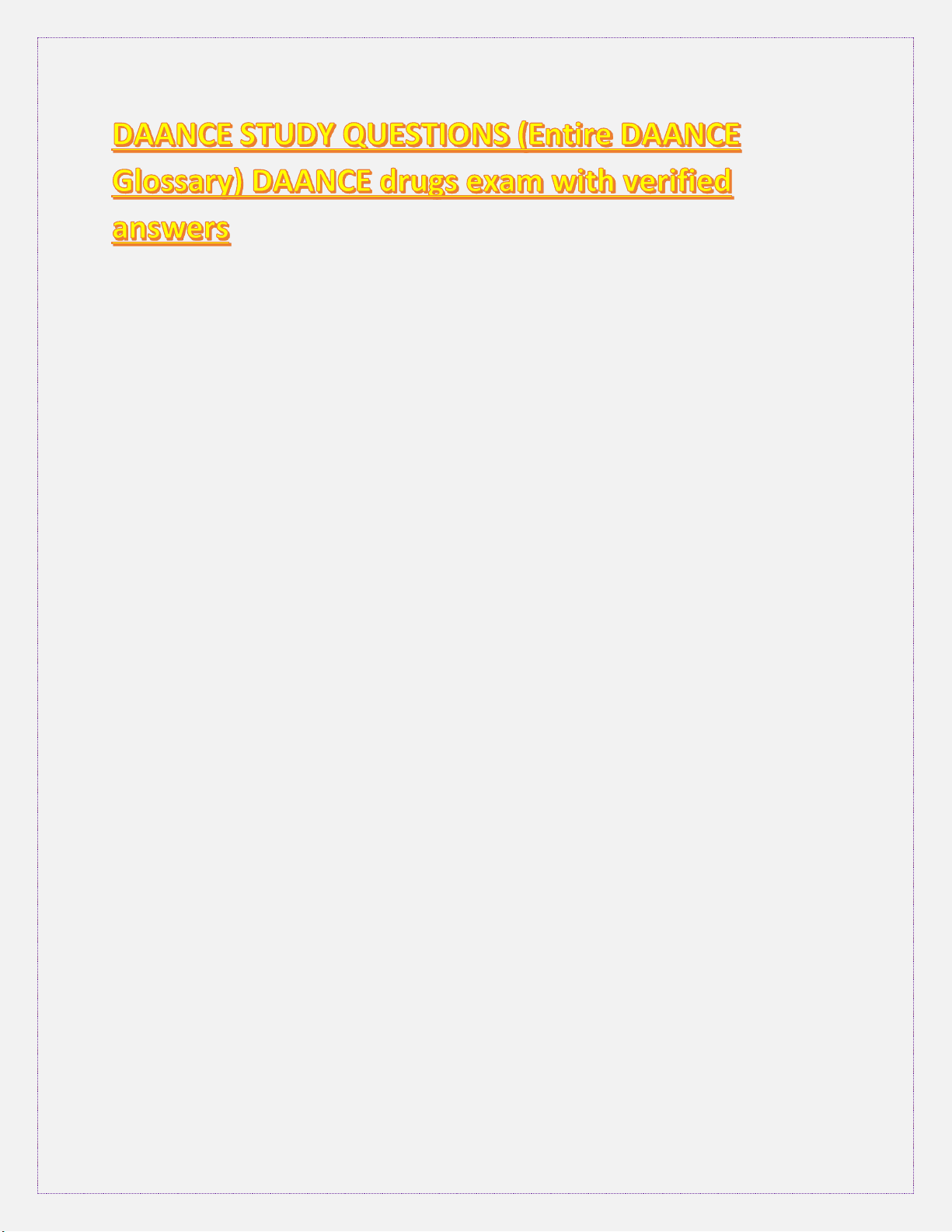
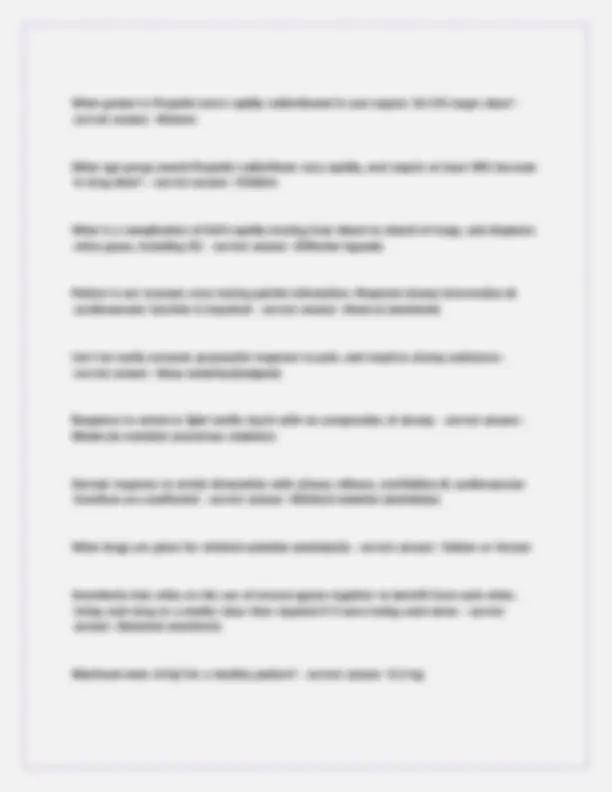
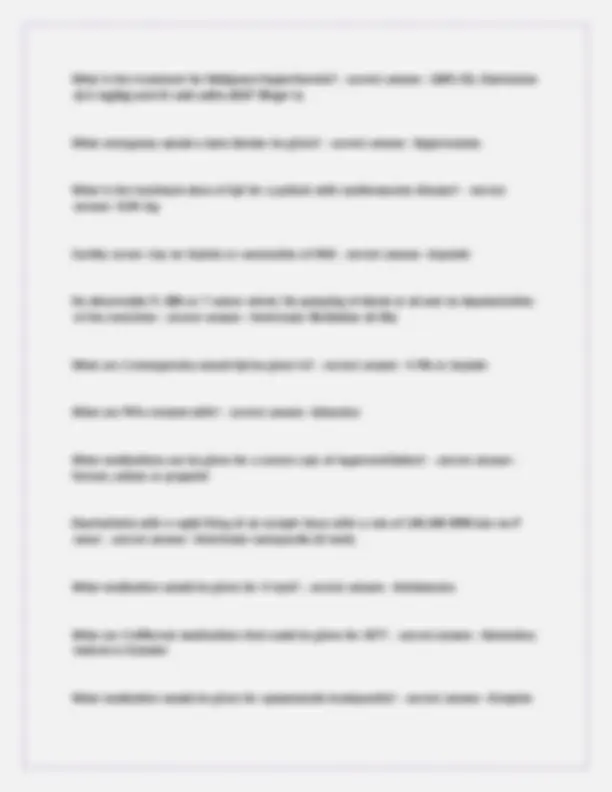
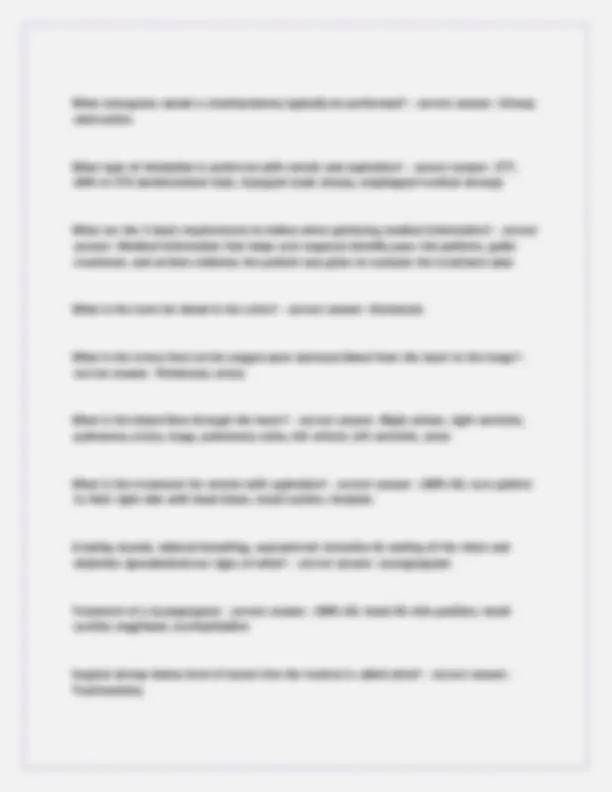
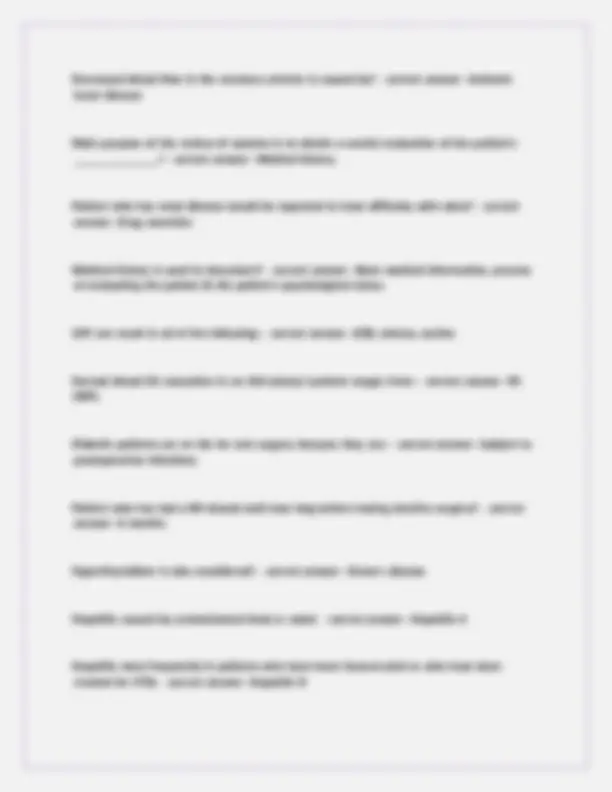
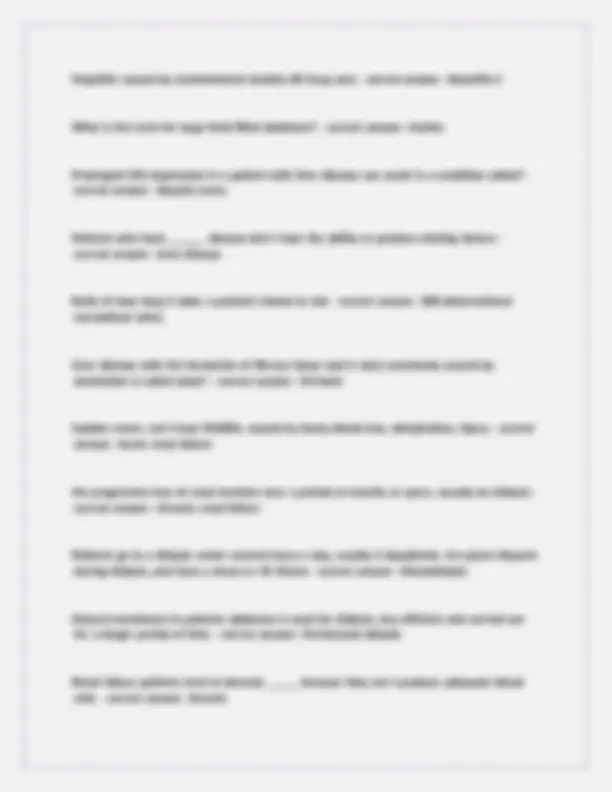
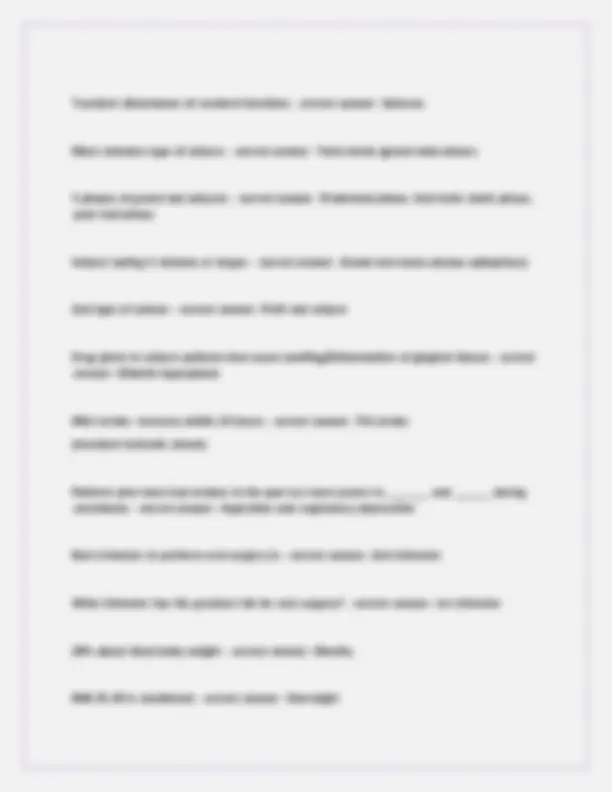
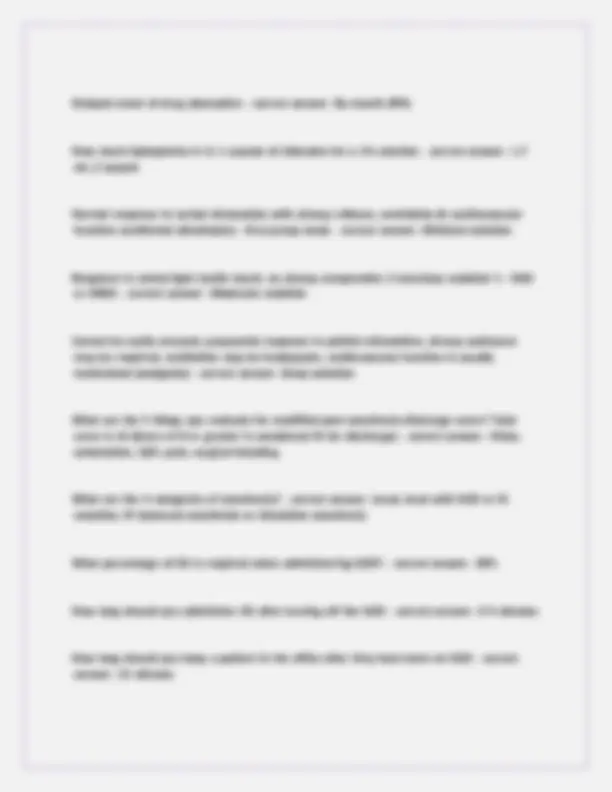
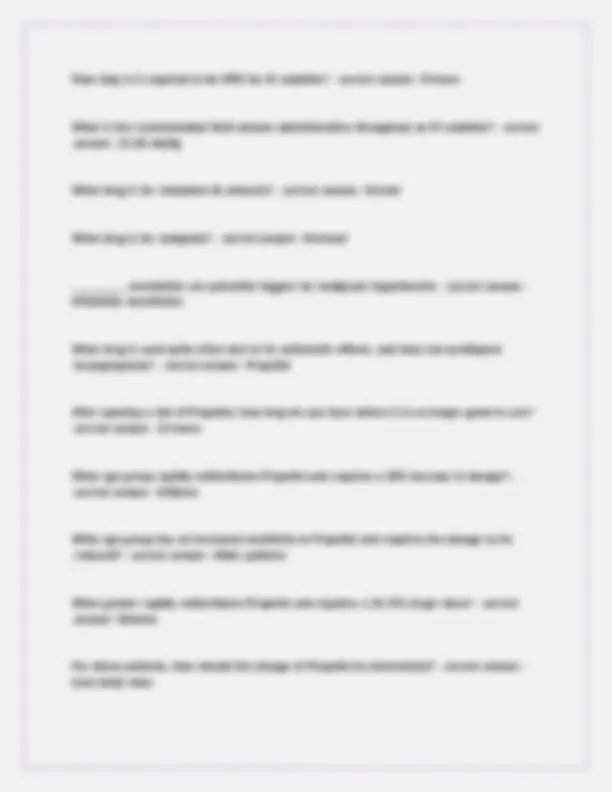
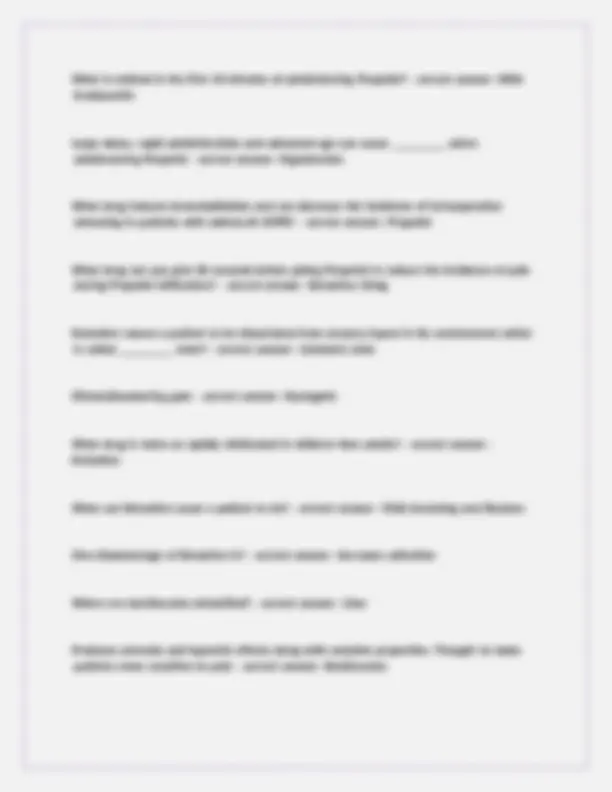
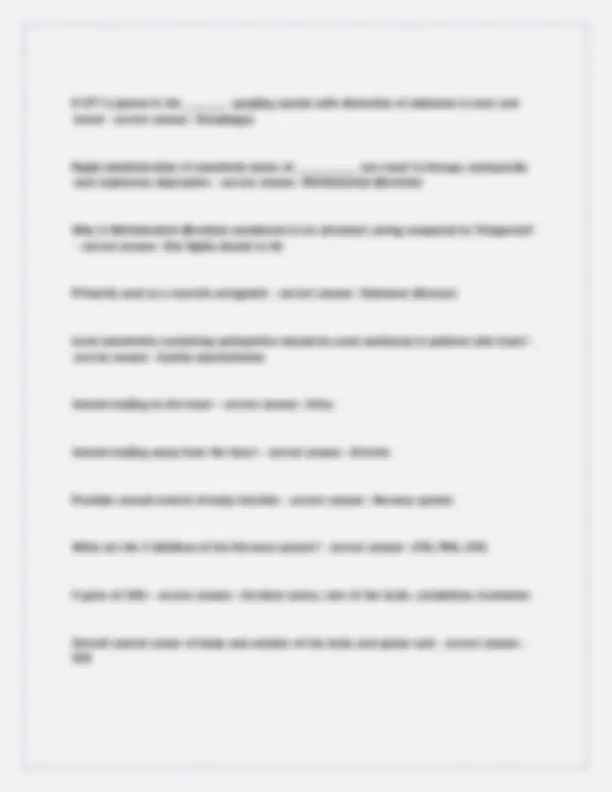
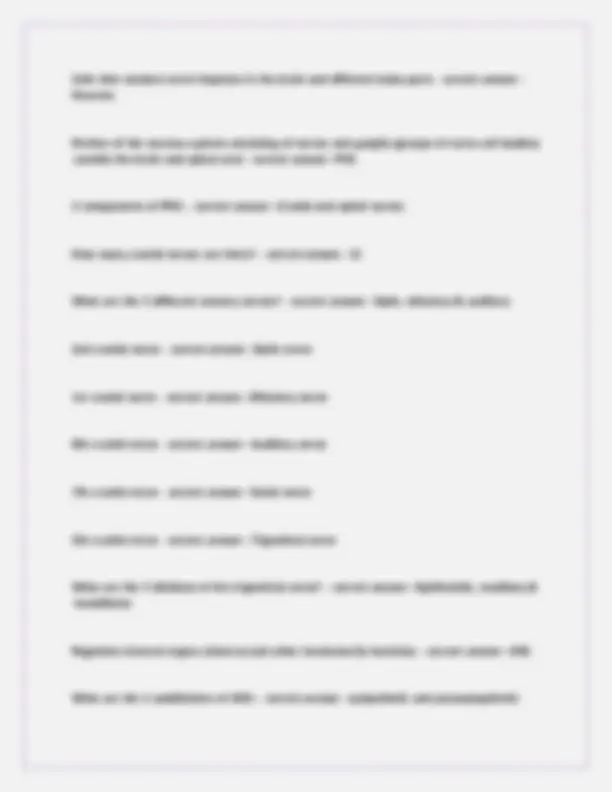
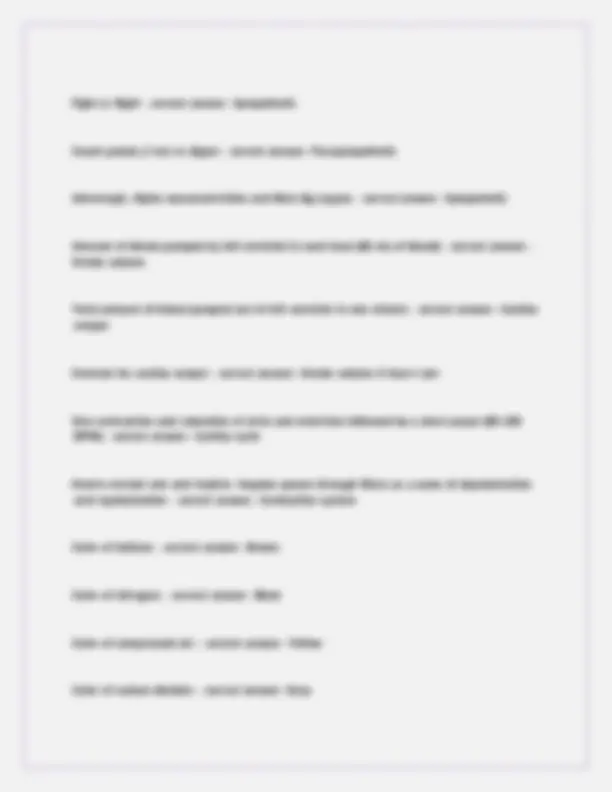
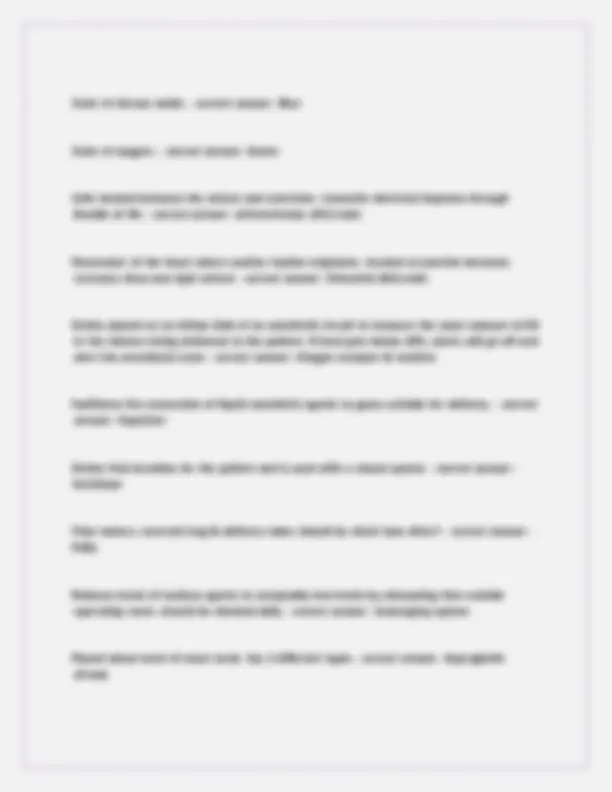
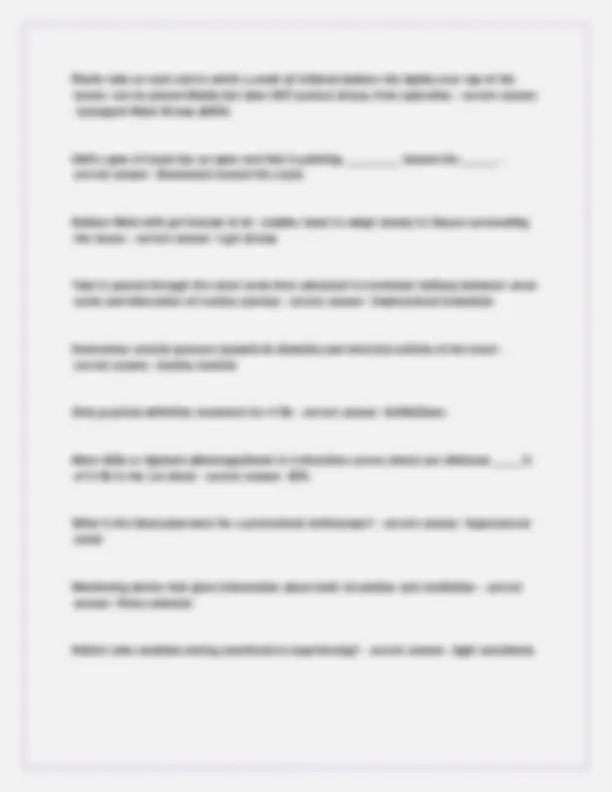
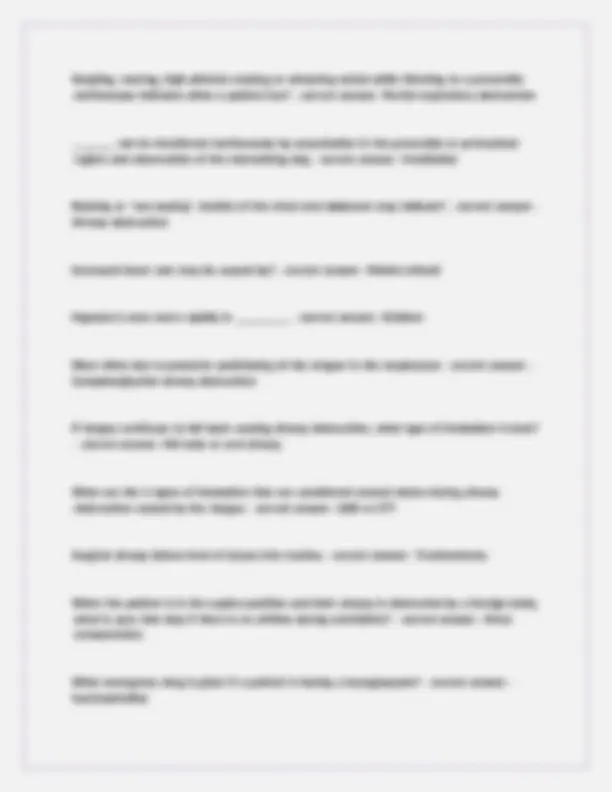
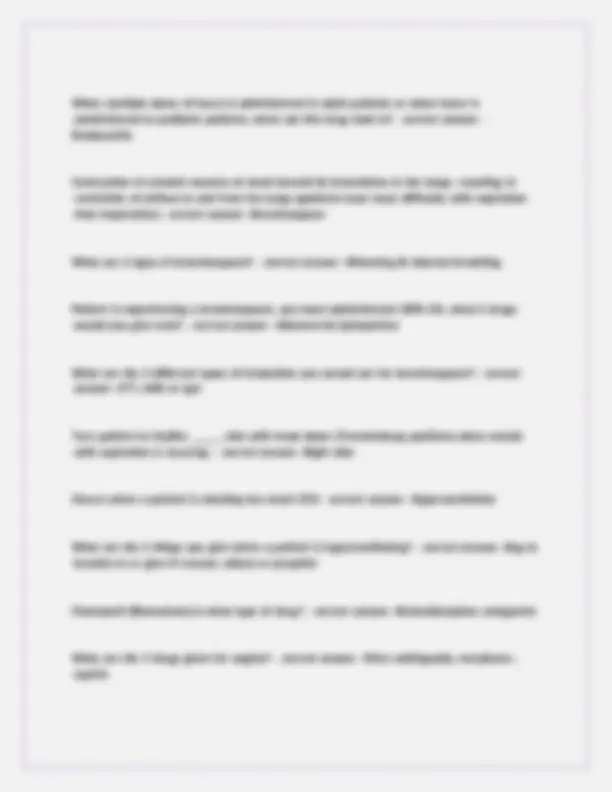
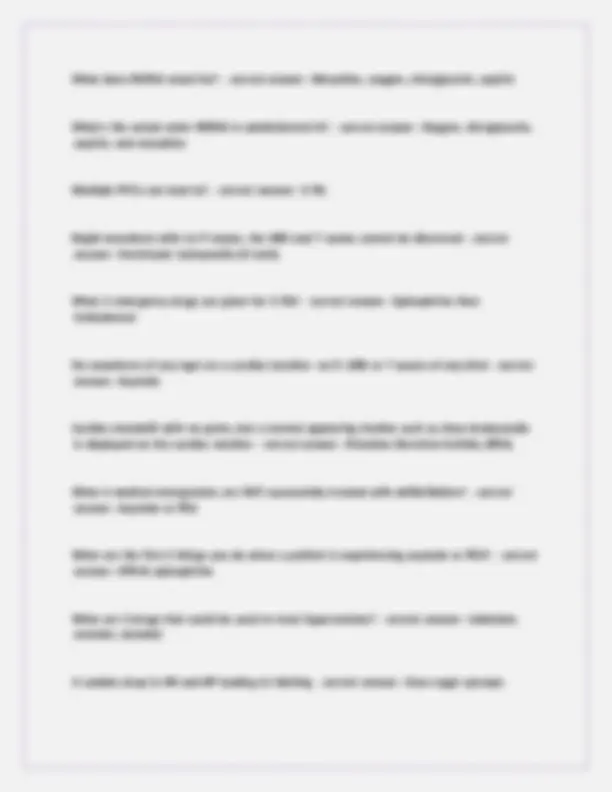
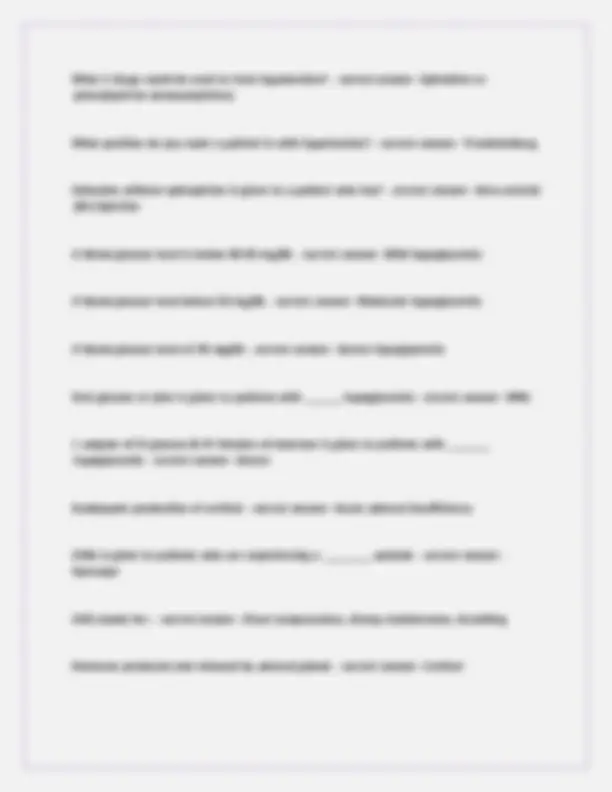
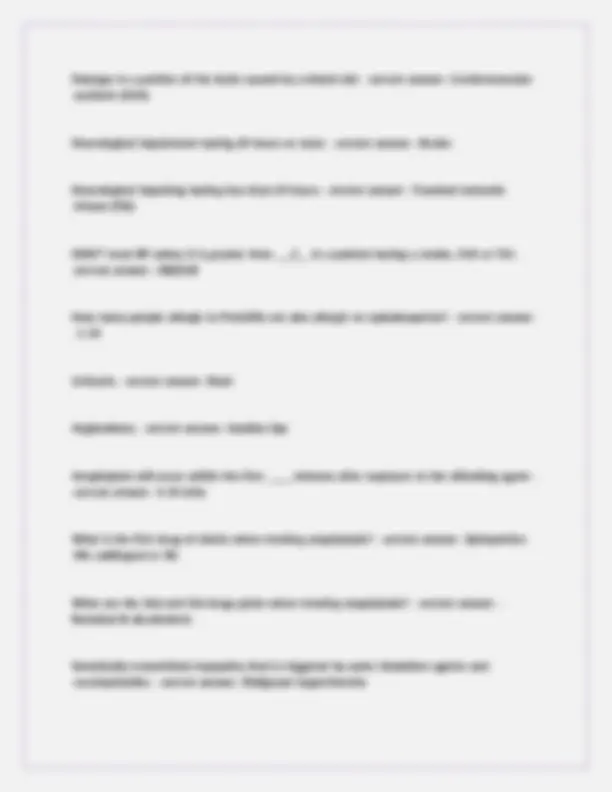
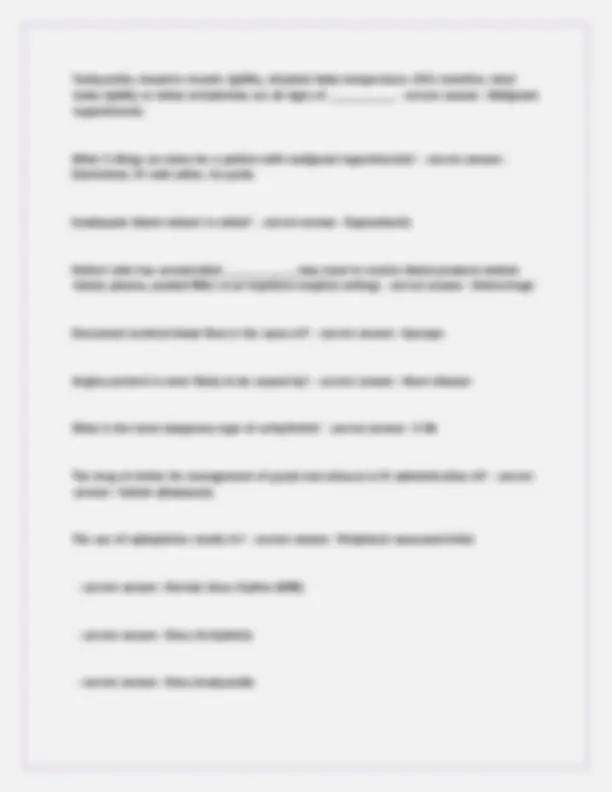
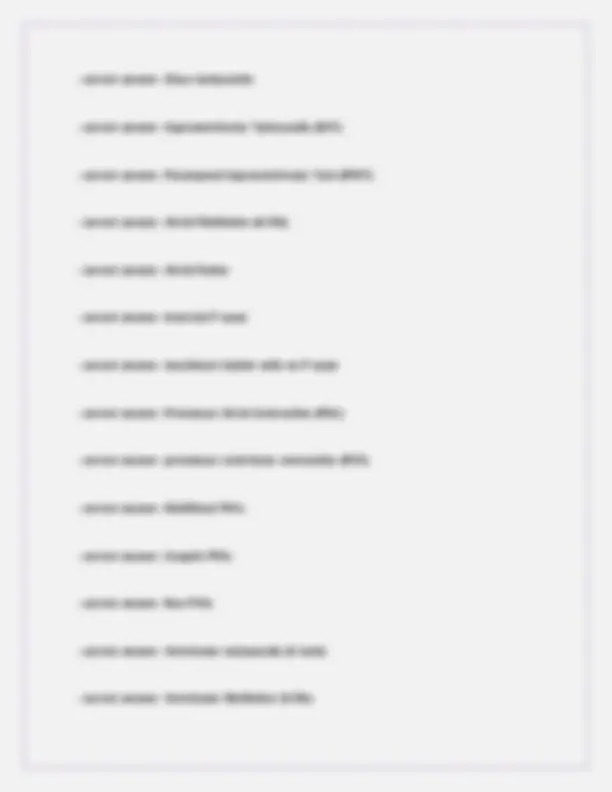
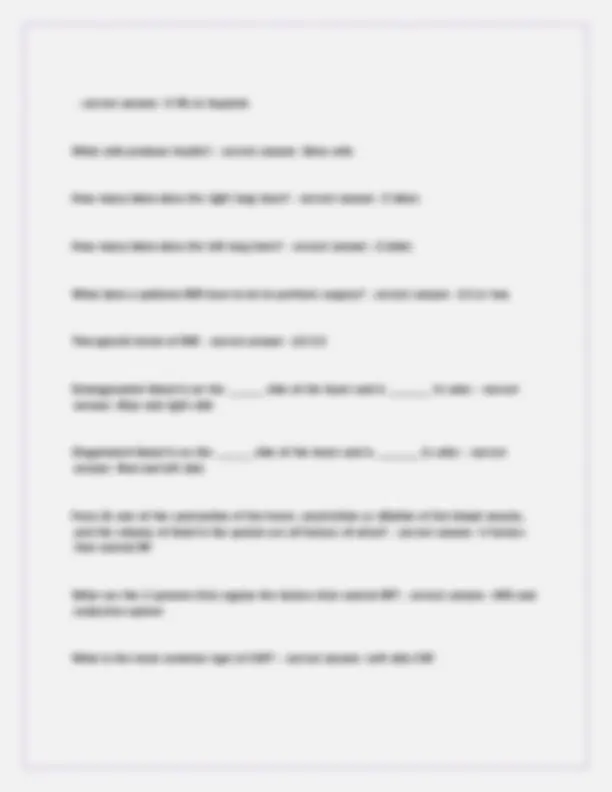
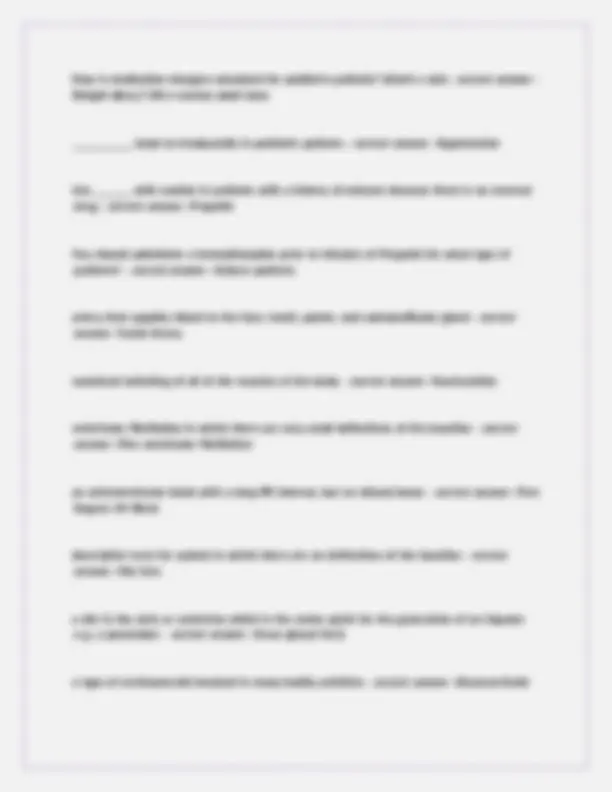
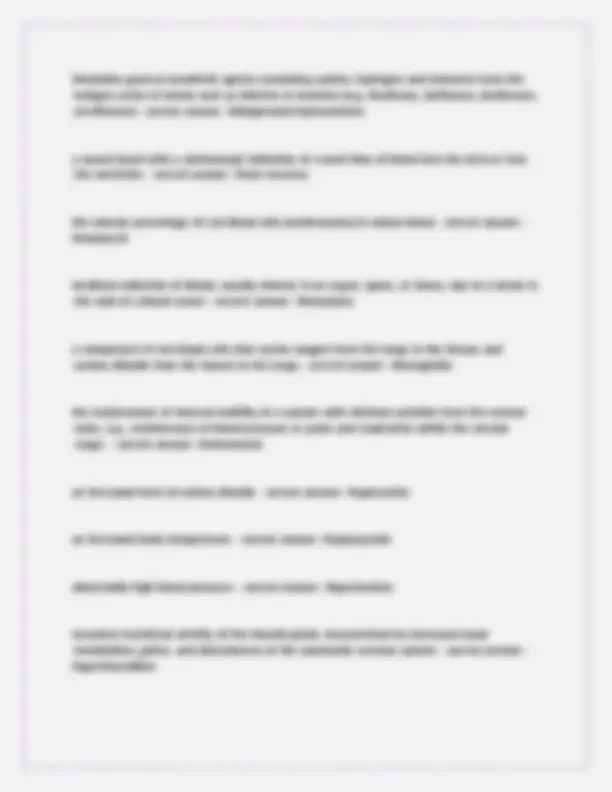
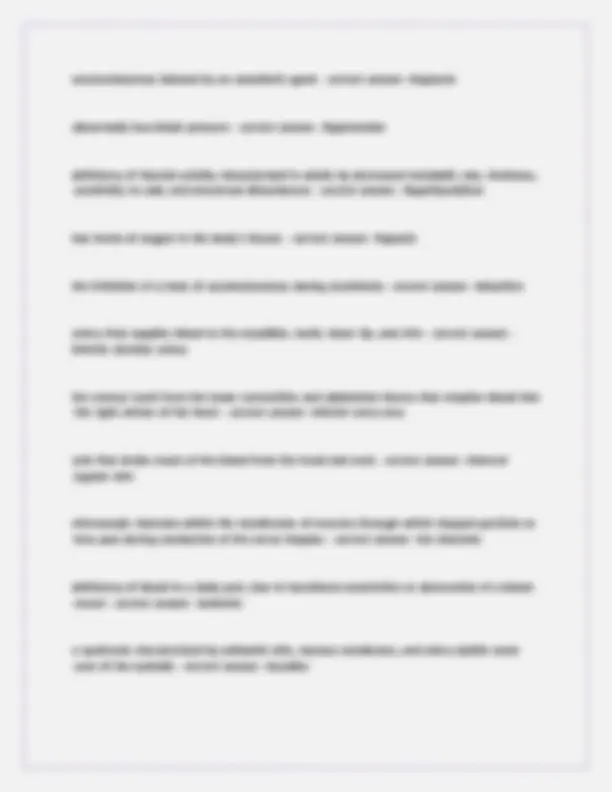
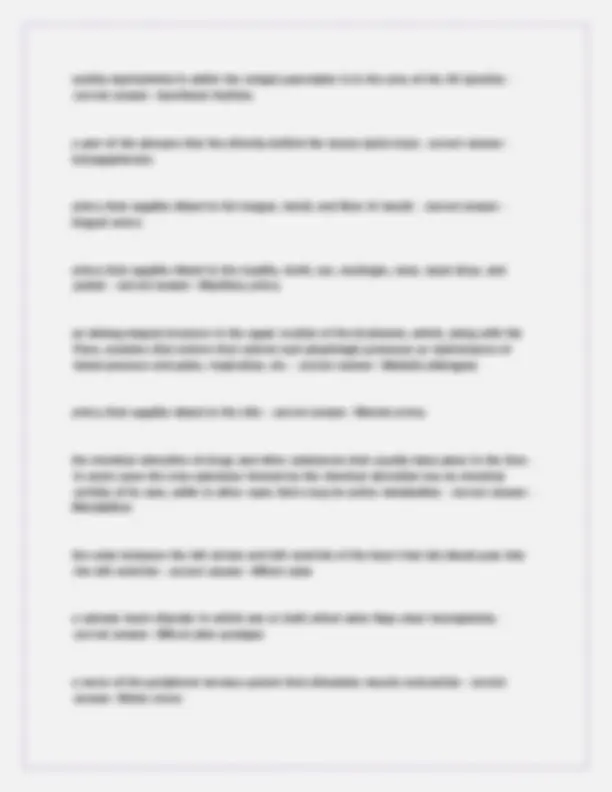
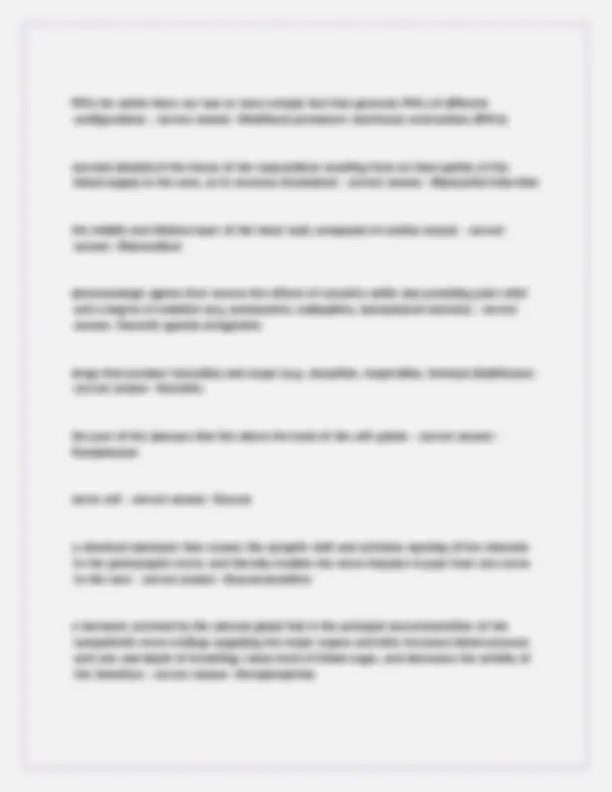
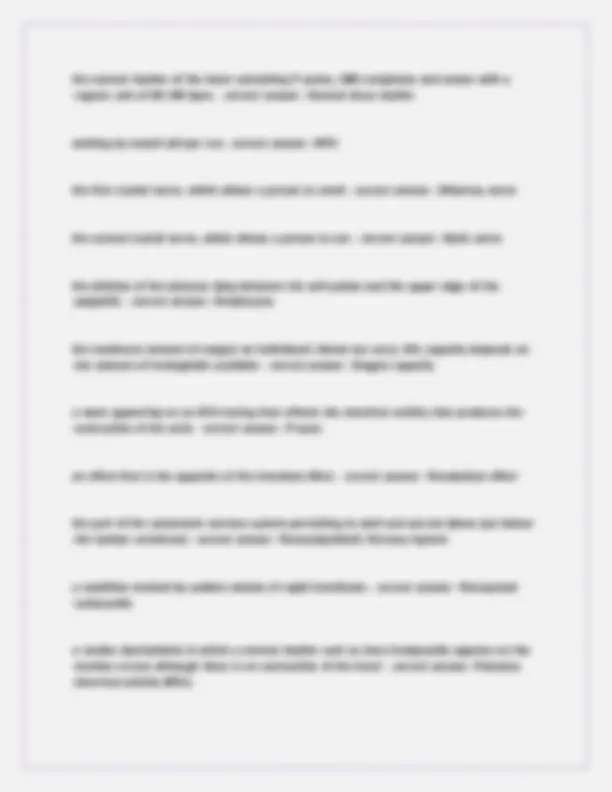
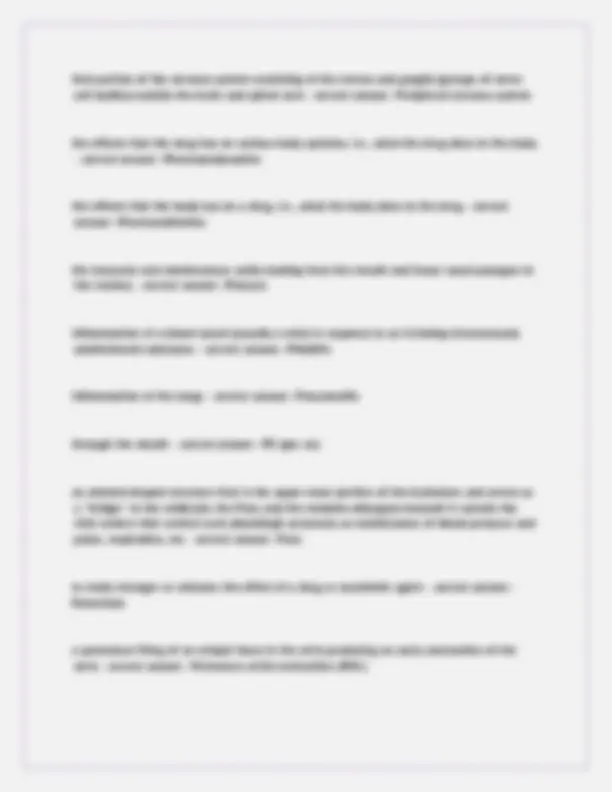
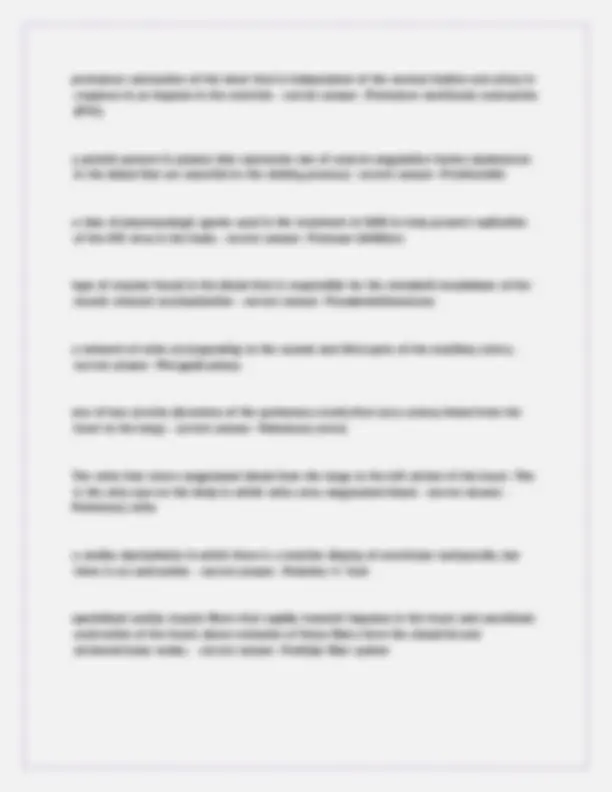
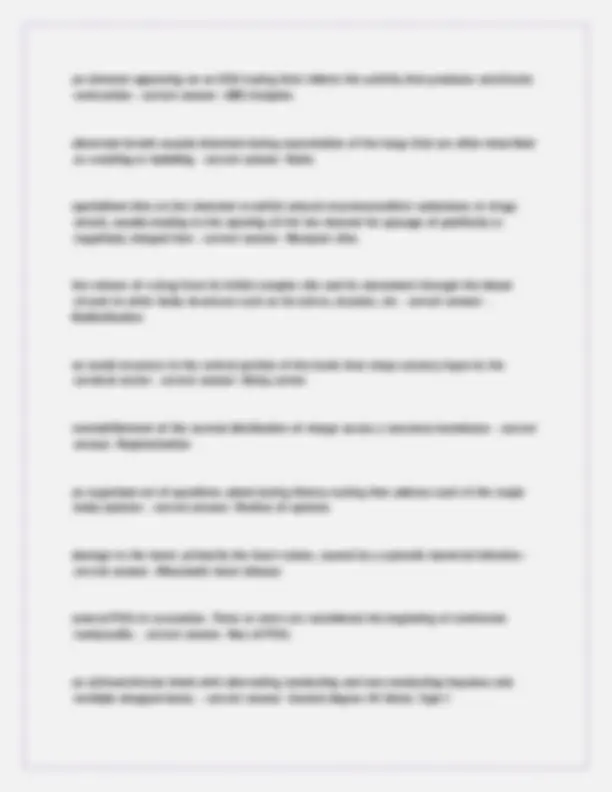
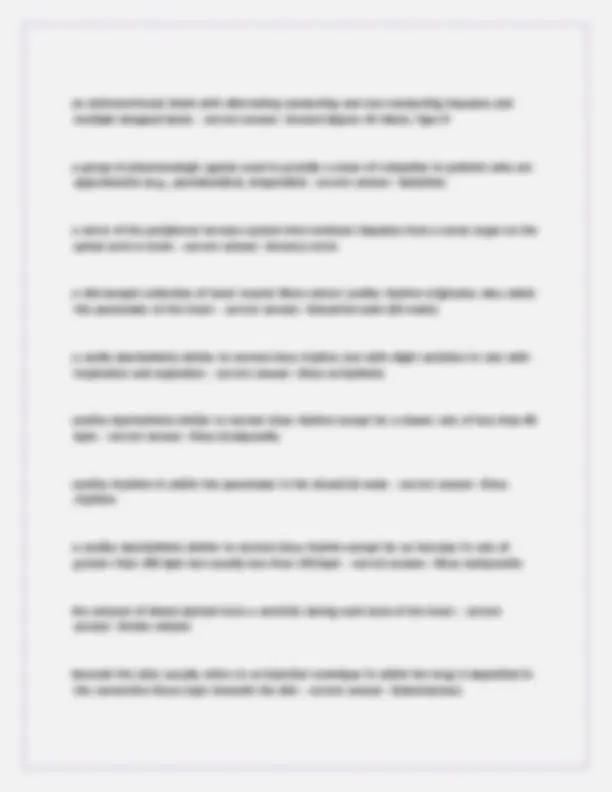
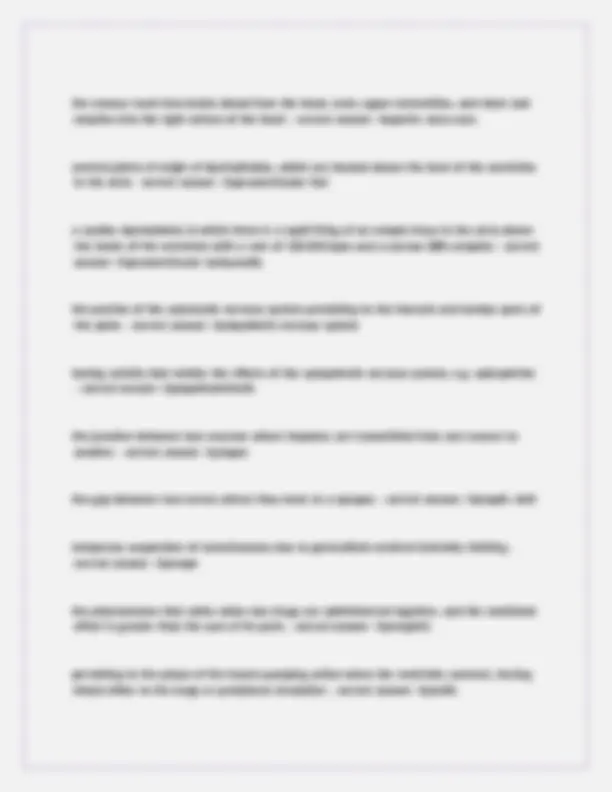
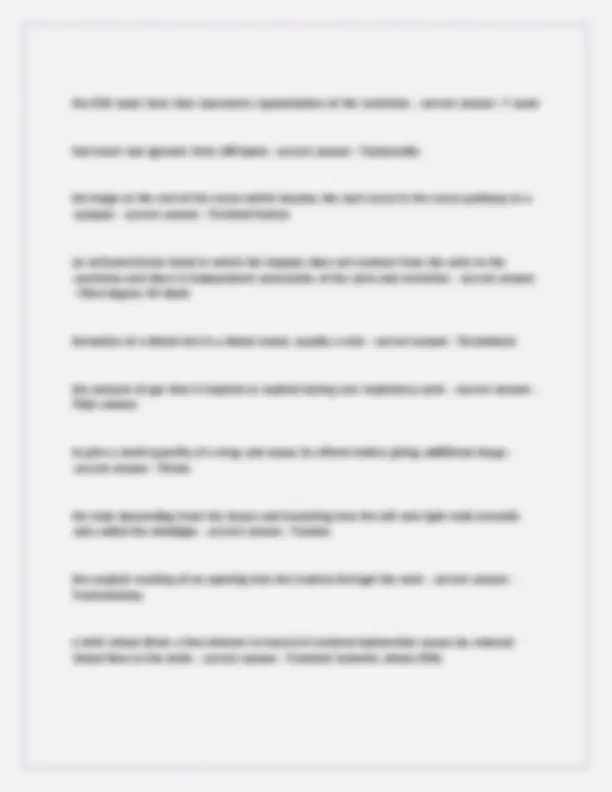
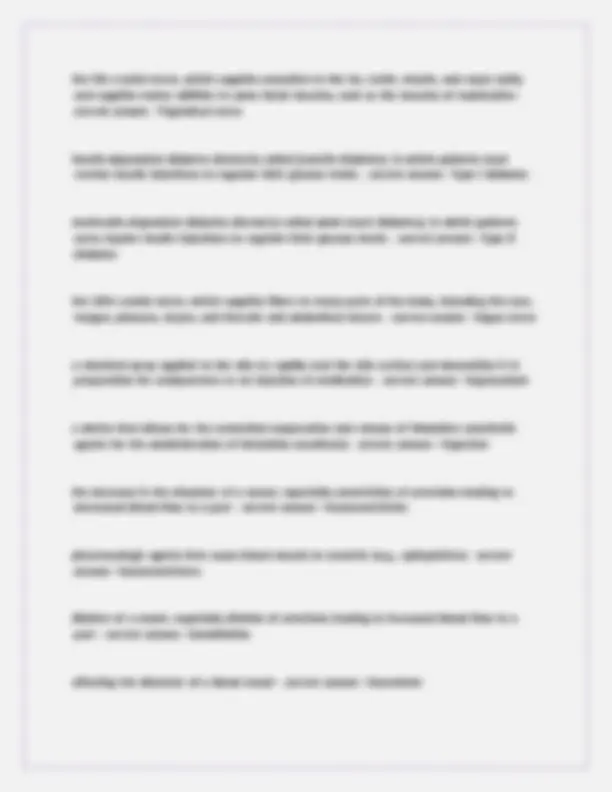
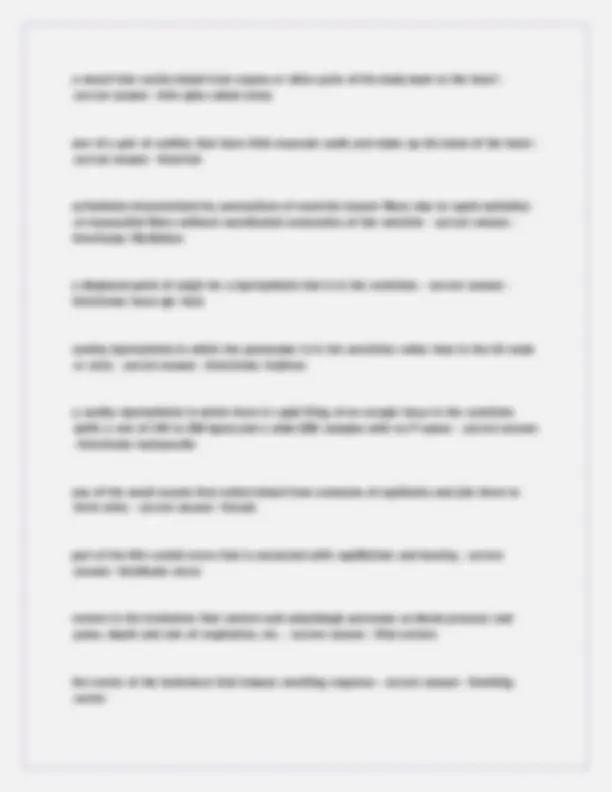
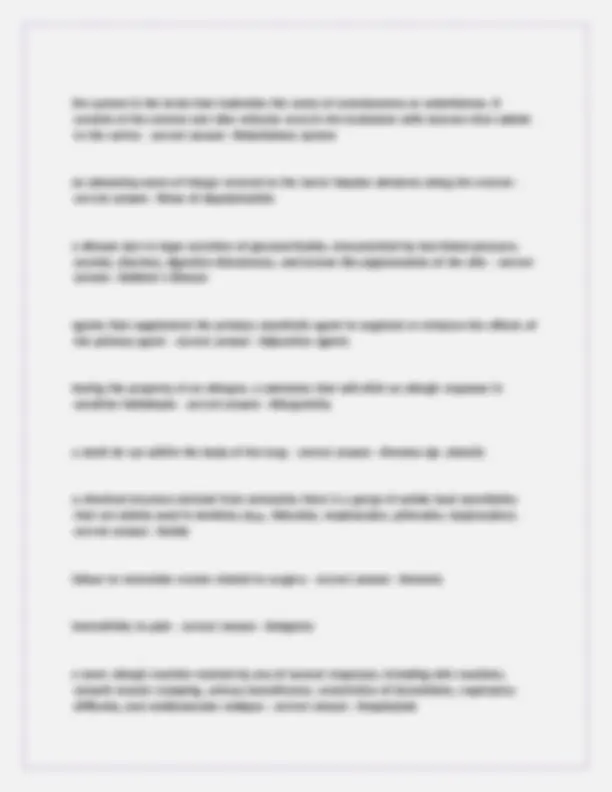
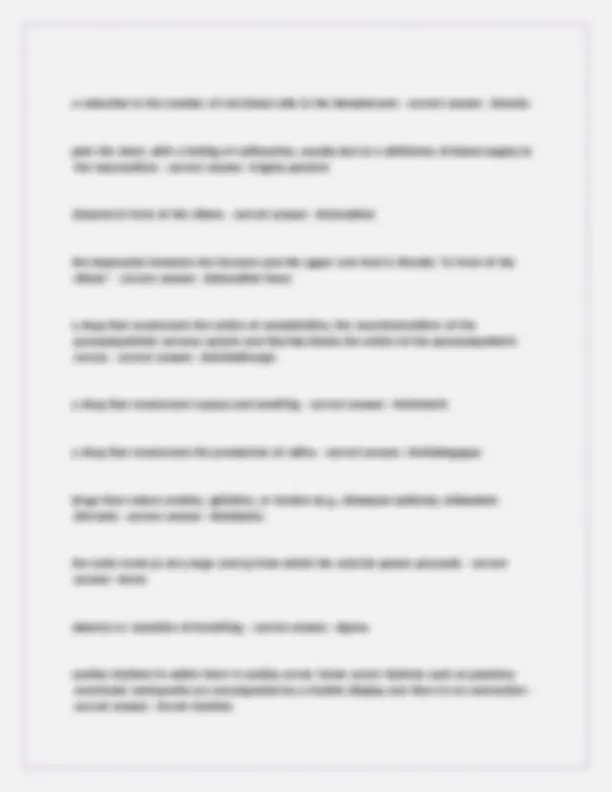
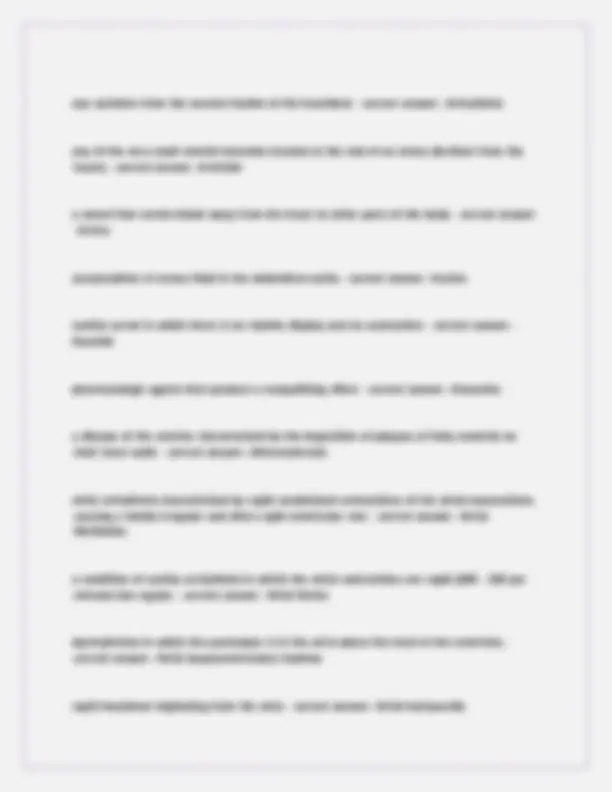
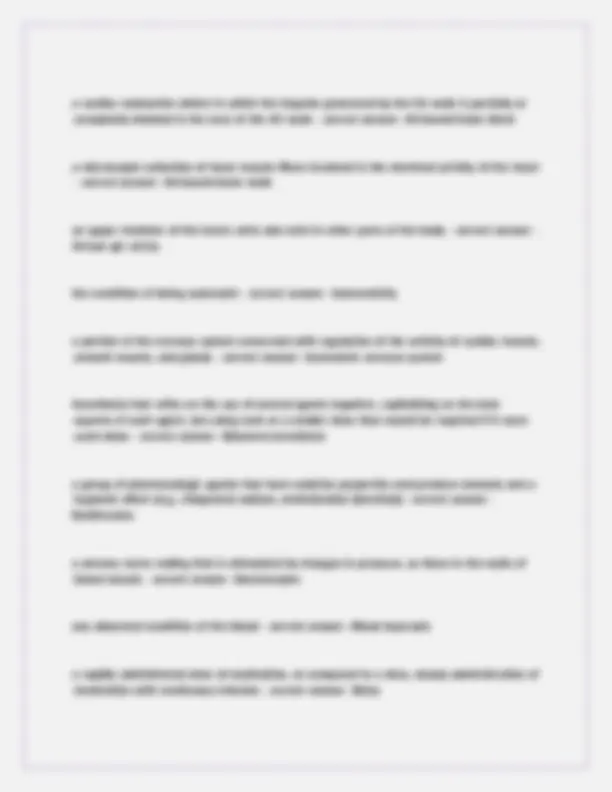
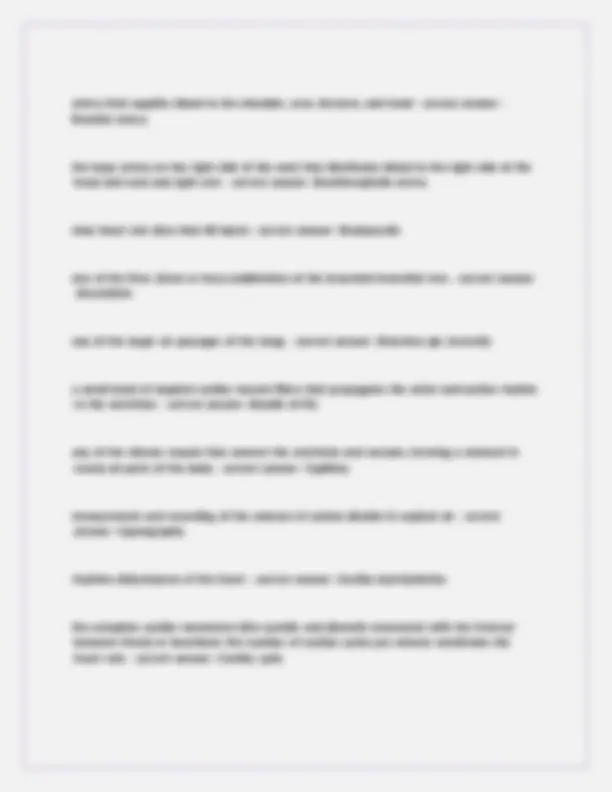
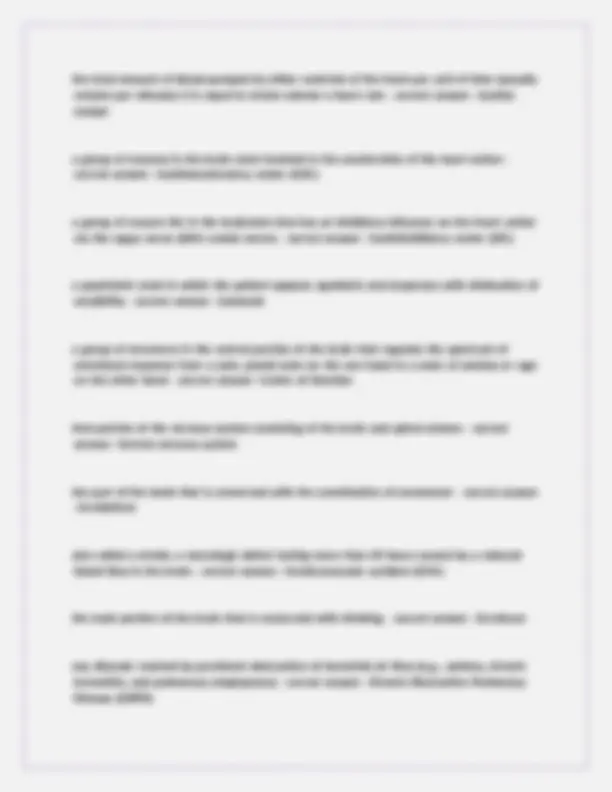
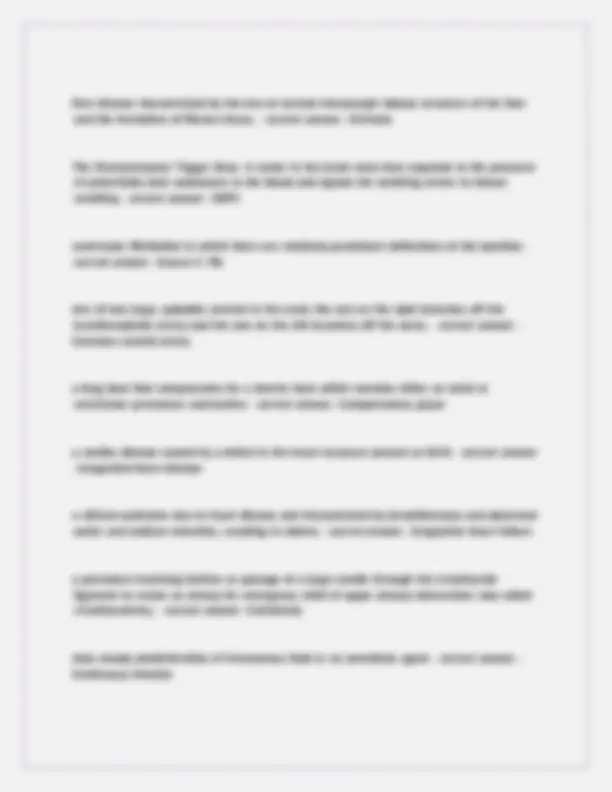
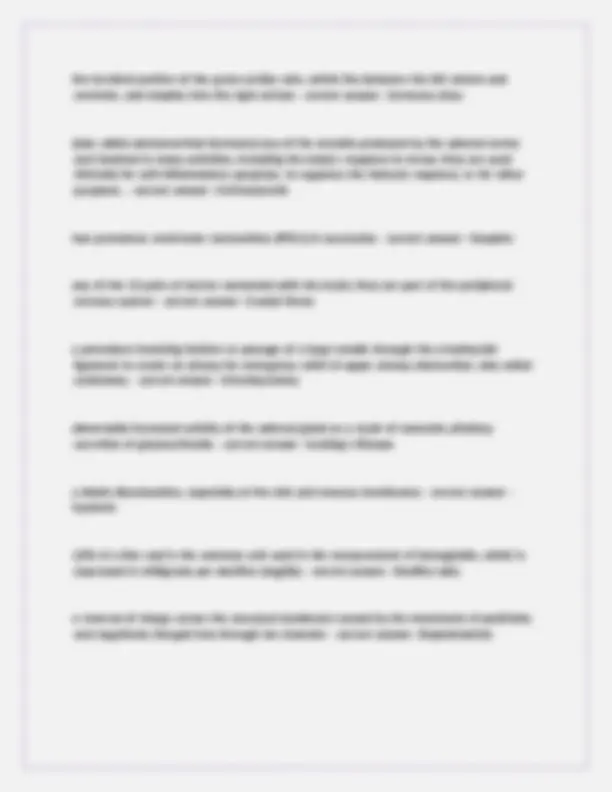
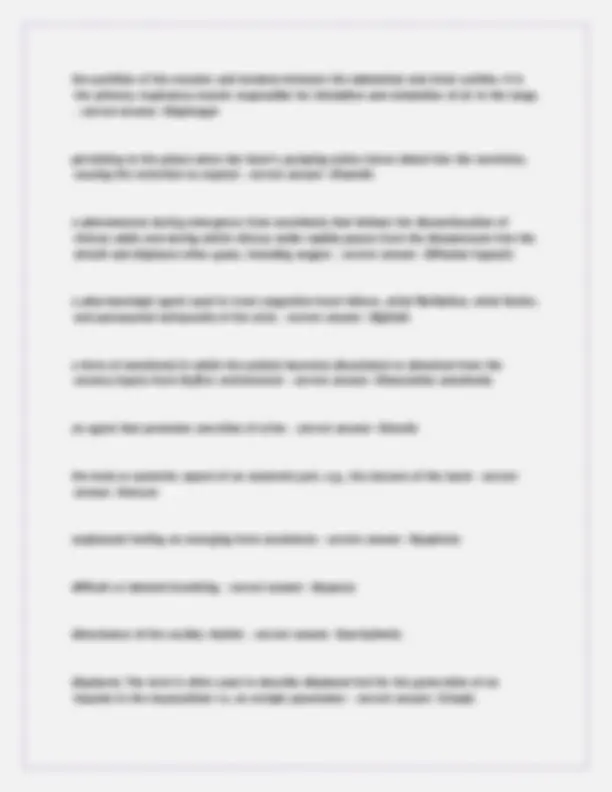
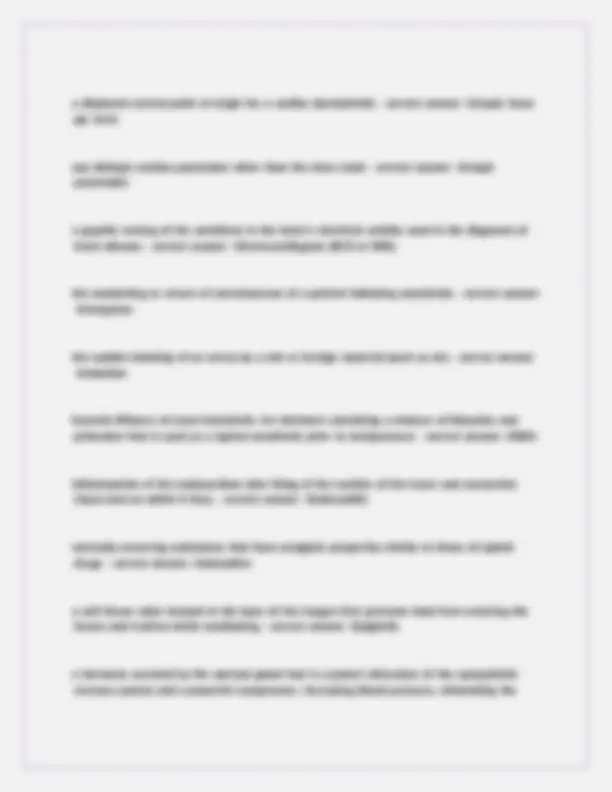
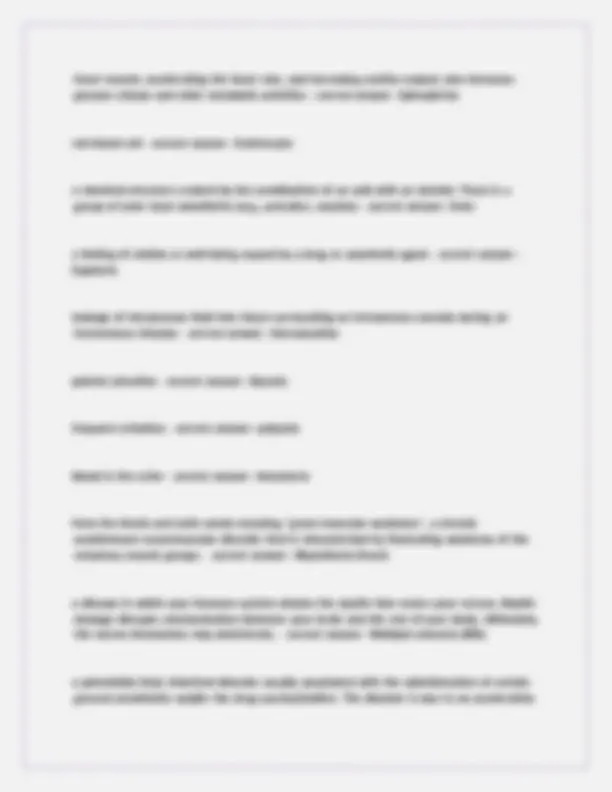
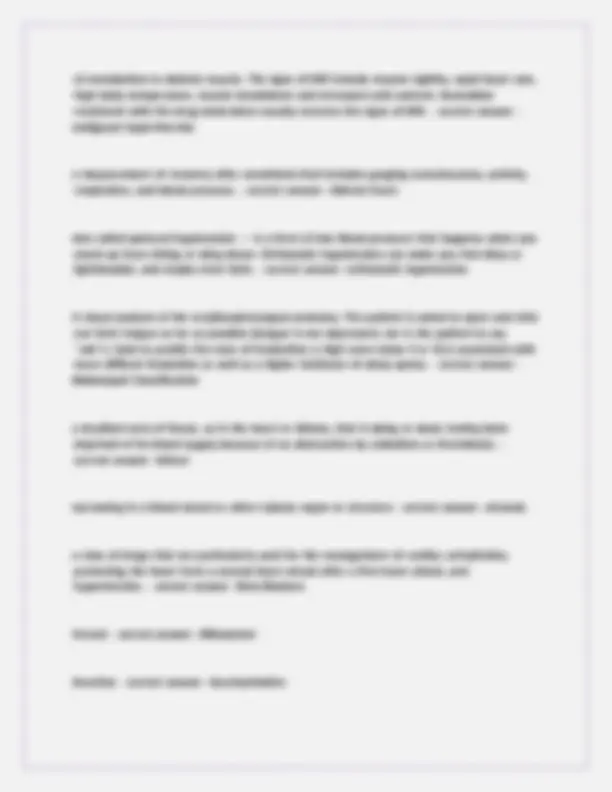
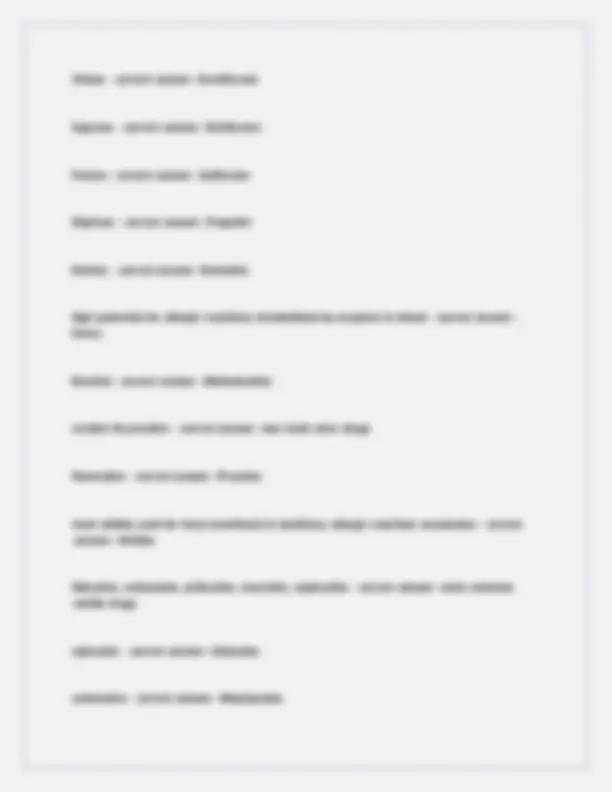
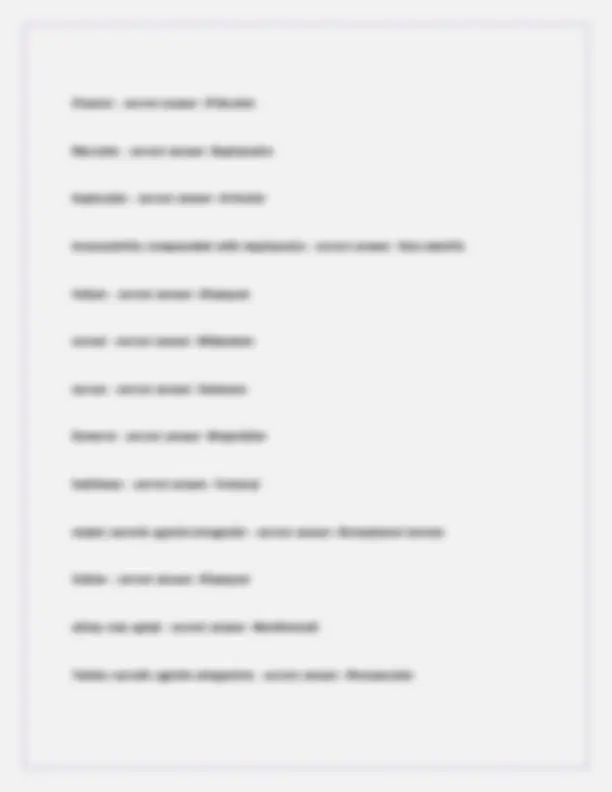
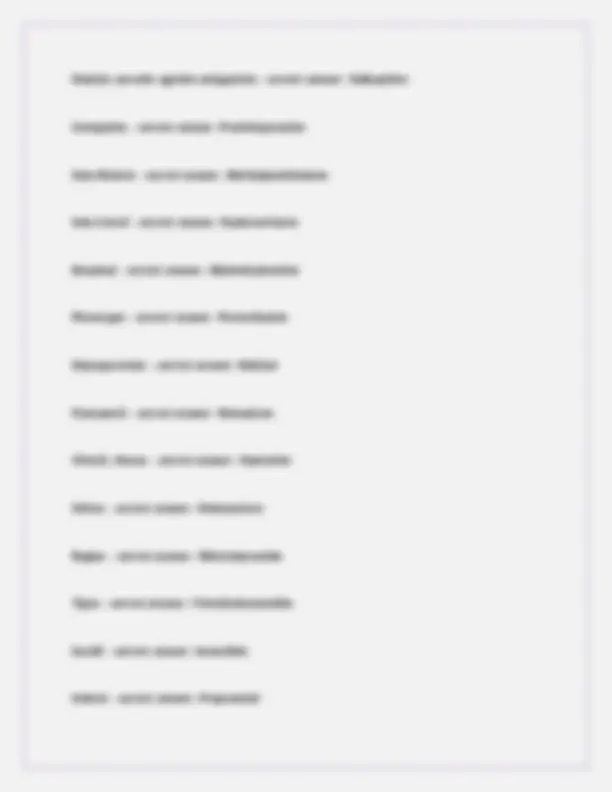
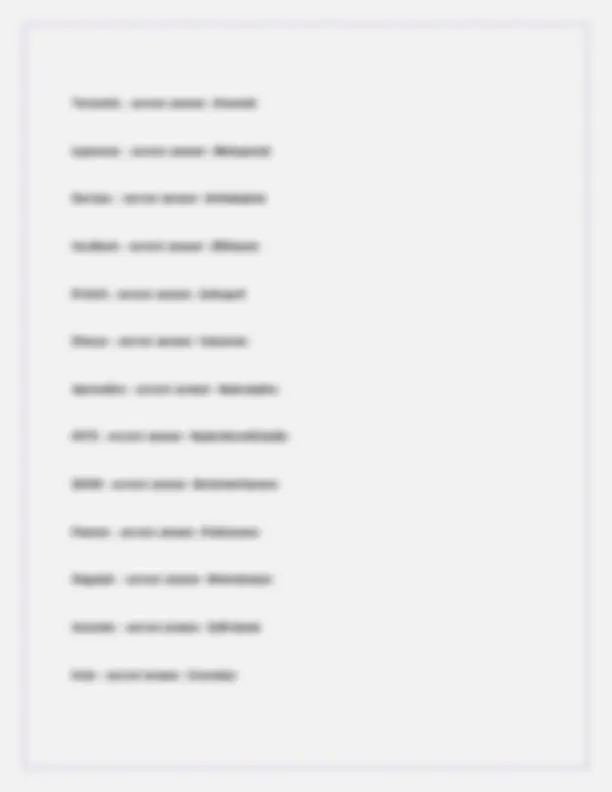
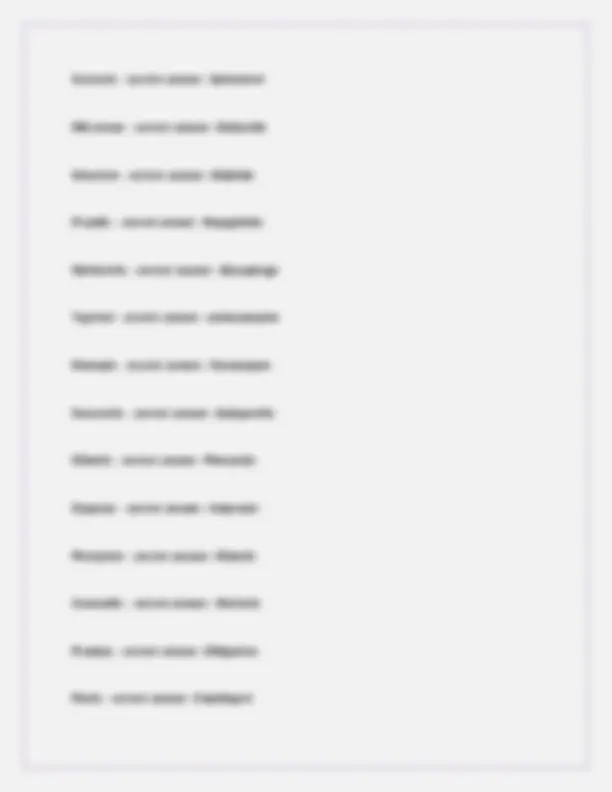
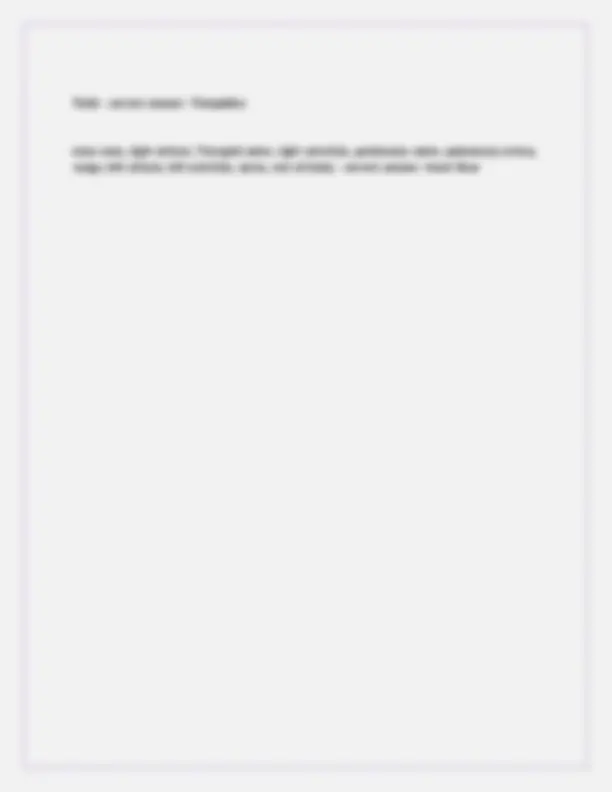


Study with the several resources on Docsity

Earn points by helping other students or get them with a premium plan


Prepare for your exams
Study with the several resources on Docsity

Earn points to download
Earn points by helping other students or get them with a premium plan
Community
Ask the community for help and clear up your study doubts
Discover the best universities in your country according to Docsity users
Free resources
Download our free guides on studying techniques, anxiety management strategies, and thesis advice from Docsity tutors
A comprehensive overview of medical terminology and concepts relevant to healthcare professionals. It covers a wide range of topics, including anatomy, physiology, diseases, treatments, and emergency procedures. Presented in a question-and-answer format, making it easy to learn and retain information. It is an excellent resource for students, nurses, and other healthcare professionals seeking to enhance their knowledge and understanding of medical concepts.
Typology: Exams
1 / 62

This page cannot be seen from the preview
Don't miss anything!























































What |consists |of |the |upper |airway? |- |correct |answer |-Nose/nasal |passages, |sinuses, |pharynx
What |consists |of |the |lower |airway? |- |correct |answer |-Larynx, |trachea, |bronchi, |bronchioles, |pulmonary |alveoli
What |is |the |most |severe |type |of |allergic |reaction? |- |correct |answer |-Immediate |hypersensitivity |response |that |involves |antigen-antibody |reactions |(IgE)
What |is |the |largest |gland |in |the |body? |- |correct |answer |-Liver
What |age |group |of |patients |will |hypoxia |occur |much |more |rapidly |in? |Bradycardia |is |a |sign |relating |to |hypoxia |- |correct |answer |-Pediatric |patients
What |does |HIPAA |stand |for? |- |correct |answer |-Health |Insurance |Portability |and |Accountability |Act |(HIPAA)
A |decrease |in |blood |flow |in |the |coronary |arteries? |Can |temporarily |or |permanently |damage |the |heart |muscle |by |decreasing |O2 |available |to |the |muscle |cells? |- |correct |answer |-Ischemia
If |a |cardiac |patient |just |had |stent |placement, |how |long |are |they |required |to |be |on |antiplatelet |drugs? |What |are |the | 2 |drugs |they |usually |do |together? |- |correct |answer |- |year- |Plavix |& |Aspirin
Type |of |infection |that |can |further |damage |heart |valves |or |cause |systemic |infections? |Requires |antibiotic |prophylaxis |- |correct |answer |-Subacute |Bacterial |Endocarditis |(SBE) |aka |infectious |endocarditis
Atrial |depolarization |(contraction) |- |correct |answer |-P |wave
Ventricular |depolarization |- |correct |answer |-QRS |complex
Ventricular |repolarization |(relaxation) |- |correct |answer |-T |wave
Type |of |disease |due |to |excessive |secretion |of |corticosteroid |due |to |a |presence |of |a |tumor |or |from |administration |of |high |doses |of |corticosteriod |drugs |(ex: |Prednisone) |- |correct |answer |-Cushing's |disease
Chronic |long-term |hypothyroidism, |most |commonly |seen |in |older |adults |(elderly |women) |who |have |had |a |stroke |or |stopped |taking |their |thyroid |medication |- |correct |answer |- Myxedema
Most |severe |complication |of |hyperthyroidism |from |an |OMS |perspective |- |correct |answer |- Thyroid |crisis
Untreated |__________ |are |at |an |increased |risk |for |outpatient |anesthesia |and |tend |to |be |sensitive |to |epinephrine |in |a |local |anesthetic |- |correct |answer |-Hyperthyroidism
Insulin-dependent |- |correct |answer |-Diabetes |Type | 1
Non-insulin |dependent |- |correct |answer |-Diabetes |Type | 2
Elevated |level |of |several |liver |enzymes |and |bilirubin |is |often |termed? |- |correct |answer |- Elevated |LFTs |(Liver |function |tests)
What |is |the |treatment |for |Malignant |Hyperthermia? |- |correct |answer |-100% |O2, |Dantrolene |(2.5 |mg/kg) |and |IV |cold |saline |(NOT |Ringer's)
What |emergency |would |a |beta |blocker |be |given? |- |correct |answer |-Hypertension
What |is |the |maximum |dose |of |Epi |for |a |patient |with |cardiovascular |disease? |- |correct |answer |-0.04 |mg
Cardiac |arrest- |has |no |rhythm |or |contraction |of |EKG |- |correct |answer |-Asystole
No |discernable |P, |QRS |or |T |waves |noted. |No |pumping |of |blood |at |all |and |no |depolarization |of |the |ventricles |- |correct |answer |-Ventricular |fibrillation |(V-fib)
What |are | 2 |emergencies |would |Epi |be |given |in? |- |correct |answer |-V-Fib |or |Asytole
What |are |PVCs |treated |with? |- |correct |answer |-Lidocaine
What |medications |can |be |given |for |a |severe |case |of |hyperventilation? |- |correct |answer |- Versed, |valium |or |propofol
Dysrhythmia |with |a |rapid |firing |of |an |ectopic |focus |with |a |rate |of |140-200 |BPM |but |no |P |wave |- |correct |answer |-Ventricular |tachycardia |(V-tach)
What |medication |would |be |given |for |V-tach? |- |correct |answer |-Amiodarone
What |are | 3 |different |medications |that |could |be |given |for |SVT? |- |correct |answer |-Adenosine, |Inderal |or |Esmolol
What |medication |would |be |given |for |symptomatic |bradycardia? |- |correct |answer |-Atropine
What |emergency |would |a |cricothyrotomy |typically |be |performed? |- |correct |answer |-Airway |obstruction
What |type |of |intubation |is |preferred |with |emesis |and |aspiration? |- |correct |answer |-ETT, |LMA |or |ETA |(endotracheal |tube, |laryngeal |mask |airway, |esophageal |tracheal |airway)
What |are |the | 3 |basic |requirements |to |follow |when |gathering |medical |information? |- |correct |answer |-Medical |information |that |helps |oral |surgeons |identify |poor-risk |patients, |guide |treatment, |and |written |evidence |the |patient |was |given |to |evaluate |the |treatment |plan
What |is |the |term |for |blood |in |the |urine? |- |correct |answer |-Hematuria
What |is |the |artery |that |carries |oxygen-poor |(venous) |blood |from |the |heart |to |the |lungs? |- |correct |answer |-Pulmonary |artery
What |is |the |blood |flow |through |the |heart? |- |correct |answer |-Right |atrium, |right |ventricle, |pulmonary |artery, |lungs, |pulmonary |veins, |left |atrium, |left |ventricle, |aorta
What |is |the |treatment |for |emesis |with |aspiration? |- |correct |answer |-100% |O2, |turn |patient |to |their |right |side |with |head |down, |tonsil |suction, |intubate
Crowing |sounds, |labored |breathing, |suprasternal |retraction |& |rocking |of |the |chest |and |abdomen |(paradoxical) |are |signs |of |what? |- |correct |answer |-Laryngospasm
Treatment |of |a |laryngospasm |- |correct |answer |-100% |O2, |head |tilt |chin |position, |tonsil |suction, |bag/mask, |succinylcholine
Surgical |airway |below |level |of |larynx |into |the |trachea |is |called |what? |- |correct |answer |- Tracheostomy
Ventricular |relaxation |is |what |phase |of |BP? |- |correct |answer |-Dystolic |blood |pressure
The |T |wave |on |a |cardiac |monitor |tracing |is |evidence |of |what |change |in |polarization? |- |correct |answer |-Repolarization |of |the |ventricles
What |anatomical |structure |located |at |the |top |of |the |larynx |closes |the |airway |and |prevents |foreign |bodies |from |entering |the |trachea? |- |correct |answer |-Epiglottis
What |is |most |likely |to |cause |obstruction |of |the |airway |when |an |anesthetized |patient |is |lying |in |a |supine |position? |- |correct |answer |-Tongue
Blood |is |pumped |to |the |lungs |from |the |heart |through |what |vessel? |- |correct |answer |- Pulmonary |artery
Small, |sac-like |structures |located |at |the |end |of |the |respiratory |tract |in |which |O2 |and |CO |are |exchanged. |- |correct |answer |-Alveoli
Soft |tissue |valve |that |covers |the |larynx |and |allows |food |to |enter |the |esophagus |is |called |the? |- |correct |answer |-Epiglottis
Artery |located |in |the |neck |that |is |readily |palpated |when |looking |for |a |patient's |pulse. |- |correct |answer |-Common |carotid
CNS |consists |of: |- |correct |answer |-Brain |and |spinal |cord
Patient |with |a |history |of |TIA |has |had |a |temporary |lessening |of? |- |correct |answer |-Blood |supply |to |the |brain
Decreased |blood |flow |in |the |coronary |arteries |is |caused |by? |- |correct |answer |-Ischemic |heart |disease
Main |purpose |of |the |review |of |systems |is |to |obtain |a |careful |evaluation |of |the |patient's |______________? |- |correct |answer |-Medical |history
Patient |who |has |renal |disease |would |be |expected |to |have |difficulty |with |what? |- |correct |answer |-Drug |excretion
Medical |history |is |used |to |document? |- |correct |answer |-Basic |medical |information, |process |of |evaluating |the |patient |& |the |patient's |psychological |status
CHF |can |result |in |all |of |the |following: |- |correct |answer |-SOB, |edema, |ascites
Normal |blood |O2 |saturation |in |an |ASA |(class) |I |patient |ranges |from: |- |correct |answer |-95- 100%
Diabetic |patients |are |at |risk |for |oral |surgery |because |they |are: |- |correct |answer |-Subject |to |postoperative |infections
Patient |who |has |had |a |MI |should |wait |how |long |before |having |elective |surgery? |- |correct |answer |-6 |months
Hyperthyroidism |is |also |considered? |- |correct |answer |-Grave's |disease
Hepatitis |caused |by |contaminated |food |or |water |- |correct |answer |-Hepatitis |A
Hepatitis |most |frequently |in |patients |who |have |been |incarcerated |or |who |have |been |treated |for |STDs |- |correct |answer |-Hepatitis |B
Transient |disturbance |of |cerebral |functions |- |correct |answer |-Seizures
Most |common |type |of |seizure |- |correct |answer |-Tonic-clonic |(grand |mal) |seizure
3 |phases |of |grand |mal |seizures |- |correct |answer |-Prodromal |phase, |ictal |tonic |clonic |phase, |post |ictal |phase
Seizure |lasting | 5 |minutes |or |longer |- |correct |answer |-Grand |mal |status |(status |epilepticus)
2nd |type |of |seizure |- |correct |answer |-Petit |mal |seizure
Drug |given |to |seizure |patients |that |cause |swelling/inflammation |of |gingival |tissues |- |correct |answer |-Dilantin |hyperplasia
Mini |stroke- |recovery |within | 24 |hours |- |correct |answer |-TIA |stroke
(transient |ischemic |attack)
Patients |who |have |had |strokes |in |the |past |are |more |prone |to |_______ |and |______ |during |anesthesia |- |correct |answer |-Aspiration |and |respiratory |obstruction
Best |trimester |to |perform |oral |surgery |in |- |correct |answer |-2nd |trimester
What |trimester |has |the |greatest |risk |for |oral |surgery? |- |correct |answer |-1st |trimester
20% |above |ideal |body |weight |- |correct |answer |-Obesity
BMI |25-29 |is |considered |- |correct |answer |-Overwight
BMI |over | 30 |is |considered |- |correct |answer |-Obese
BMI |over | 40 |is |considered |- |correct |answer |-Morbidly |obese
Cessation |of |air |flow |for |more |than | 10 |seconds |- |correct |answer |-Obstructive |sleep |apnea |(OSA)
Patients |INR |is |often |_____ |when |on |Coumadin |- |correct |answer |-2-
How |long |should |a |patient |hold |their |Coumadin |prior |to |surgery? |- |correct |answer |-3-4 |days
Given |IV |only, |immediate |effect |and |wears |off |rapidly. |Given |to |patients |on |Coudmadin |- |correct |answer |-Heparin
Medications |that |interfere |with |platelets |developing |"sticky" |characteristics. |Life |cycle |of |these |drugs |are |7-10 |days |- |correct |answer |-Plavix, |Aspirin, |Ticlid
4 |most |common |drugs |used |together |for |balanced |anesthesia |- |correct |answer |-Propofol, |ketamine, |versed, |fentanyl
Inability |to |feel |pain |- |Fentanyl, |ketamine |& |local |- |correct |answer |-Analgesia
Loss |of |memory |- |Versed |& |valium |- |correct |answer |-Amnesia
4 |drugs |that |can |be |essential |for |a |patient |to |be |relaxed |and |immobile |during |procedure. |- |correct |answer |-Versed, |propofol, |brevital |& |ketamine
Loss |of |consciousness |"put |to |sleep"- |Propofol |& |brevital |- |correct |answer |-Hypnosis
Delayed |onset |of |drug |absorption |- |correct |answer |-By |mouth |(PO)
How |much |Epinephrine |is |in | 1 |carpule |of |Lidocaine |for |a |1% |solution |- |correct |answer |-1. |mL |/ |carpule
Normal |response |to |verbal |stimulation |with |airway |reflexes, |ventilation |& |cardiovascular |function |uneffected |(Anxiolysis) |- |Oral |preop |meds |- |correct |answer |-Minimal |sedation
Response |to |verbal |light |tactile |touch, |no |airway |compromise |("conscious |sedation") |- |N2O |or |EMLA |- |correct |answer |-Moderate |sedation
Cannot |be |easily |aroused, |purposeful |response |to |painful |stimulation, |airway |assistance |may |be |required, |ventilation |may |be |inadequate, |cardiovascular |function |is |usually |maintained |(analgesia) |- |correct |answer |-Deep |sedation
What |are |the | 5 |things |you |evaluate |for |modified |post-anesthesia |discharge |score? |Total |score |is | 10 |(Score |of | 9 |or |greater |is |considered |fit |for |discharge) |- |correct |answer |-Vitals, |ambulation, |N/V, |pain, |surgical |bleeding
What |are |the | 4 |categories |of |anesthesia? |- |correct |answer |-Local, |local |with |N2O |or |IV |sedation, |IV |balanced |anesthesia |or |inhalation |anesthesia
What |percentage |of |O2 |is |required |when |administering |N2O? |- |correct |answer |-30%
How |long |should |you |administer |O2 |after |turning |off |the |N2O |- |correct |answer |-3-4 |minutes
How |long |should |you |keep |a |patient |in |the |office |after |they |have |been |on |N2O |- |correct |answer |-15 |minutes
How |long |is |it |required |to |be |NPO |for |IV |sedation? |- |correct |answer |-8 |hours
What |is |the |recommended |fluid |volume |administration |throughout |an |IV |sedation? |- |correct |answer |-15-20 |mL/kg
What |drug |is |for |relaxation |& |amnesia? |- |correct |answer |-Versed
What |drug |is |for |analgesia? |- |correct |answer |-Fentanyl
_________ |anesthetics |are |potential |triggers |for |malignant |hypothermia |- |correct |answer |- Inhalation |anesthetics
What |drug |is |used |quite |often |due |to |its |antiemetic |effects, |and |does |not |predispose |laryngospasms? |- |correct |answer |-Propofol
After |opening |a |vial |of |Propofol, |how |long |do |you |have |before |it |is |no |longer |good |to |use? |- |correct |answer |-12 |hours
What |age |group |rapidly |redistributes |Propofol |and |requires |a |50% |increase |in |dosage? |- |correct |answer |-Children
What |age |group |has |an |increased |sensitivity |to |Propofol |and |requires |the |dosage |to |be |reduced? |- |correct |answer |-Older |patients
What |gender |rapidly |redistributes |Propofol |and |requires |a |10-15% |larger |dose? |- |correct |answer |-Women
For |obese |patients, |how |should |the |dosage |of |Propofol |be |determined? |- |correct |answer |- Lean |body |mass
What |is |most |frequently |encountered |during |injection |in |posterior |aspect |of |maxilla |in |the |3rd |molar |region? |- |correct |answer |-Hematomas
Metabolized |in |bloodstream |by |pseudocholinesterase |- |correct |answer |-Esters
Metabolized |in |the |liver |- |correct |answer |-Amides
2 |types |of |Esters |- |correct |answer |-Cocaine |& |Procaine
5 |types |of |Amides |- |correct |answer |-Lidocaine, |mepivacaine, |prilocaine, |bupivacaine, |articaine
Dilate |blood |vessels |- |correct |answer |-Vasonconstrictors
Maximum |amount |of |Lidocaine |for |an |average |patient |- |correct |answer |-10-11 |carpules
Maximum |amount |of |Mepivacaine |for |an |adult |patient |- |correct |answer |-7-8 |carpules
Maximum |amount |of |Prilocaine |for |a |patient |- |correct |answer |-6 |carpules
Maximum |amount |of |Bupivacaine |for |a |patient |- |correct |answer |-10 |carpules
Maximum |amount |of |Articaine |for |a |patient |- |correct |answer |-7 |carpules
This |type |of |injection |in |a |vessel |can |lead |to |tachycardia, |hypertension |and |sense |of |heart |pounding |in |chest |- |correct |answer |-Inadverent |injection |of |Epinephrine
What |percentage |of |O2 |is |in |room |air? |- |correct |answer |-20% |O
How |long |is |the |contact |time |for |EMLA |cream |to |be |sufficient? |- |correct |answer |-1 |hour
Level |of |CO2 |expired |in |each |breath- |this |is |mandatory |when |an |ETT |is |being |used |- |correct |answer |-Capnography
_________ |is |100X |more |potent |than |morphine |- |correct |answer |-Fentanyl
Rapid |onset |of |Remifentanil |- |correct |answer |-1 |minute
Patients |over | 65 |should |have |remifentanil |dosage |decreased |by |______ |- |correct |answer |- 50%
Counteract |parasympathetic |effects |- |ex: |Atropine, |Robinul |or |Scopolamine |- |correct |answer |-Anticholingeric |drugs
What |can |be |used |as |a |local |anesthetic |for |patients |allergic |to |multiple |types |of |local? |- |correct |answer |-Benadryl
Steroid |based |muscle |relaxant |that |has |an |advantage |of |NOT |triggering |malignant |hypothermia |- |correct |answer |-Rocuronium
What |drug |can |trigger |Malignant |Hypothermia? |- |correct |answer |-Succinylcholine
Inserted |orally |or |nasally- |protects |against |aspiration, |but |requires |Succs |or |Rocuronium |to |be |given |first |- |correct |answer |-ETT
If |a |tube |is |passed |into |the |right |mainstem |bronchus |- |you |can |hear |the |_____ |side |but |nothing |on |the |_____ |side |- |correct |answer |-Right |then |left
Cells |that |conduct |nerve |impulses |in |the |brain |and |different |body |parts |- |correct |answer |- Neurons
Portion |of |the |nervous |system |consisting |of |nerves |and |ganglia |(groups |of |nerve |cell |bodies) |outside |the |brain |and |spinal |cord |- |correct |answer |-PNS
2 |components |of |PNS: |- |correct |answer |-Cranial |and |spinal |nerves
How |many |cranial |nerves |are |there? |- |correct |answer |-
What |are |the | 3 |different |sensory |nerves? |- |correct |answer |-Optic, |olfactory |& |auditory
2nd |cranial |nerve |- |correct |answer |-Optic |nerve
1st |cranial |nerve |- |correct |answer |-Olfactory |nerve
8th |cranial |nerve |- |correct |answer |-Auditory |nerve
7th |cranial |nerve |- |correct |answer |-Facial |nerve
5th |cranial |nerve |- |correct |answer |-Trigeminal |nerve
What |are |the | 3 |divisions |of |the |trigeminal |nerve? |- |correct |answer |-Ophthalmic, |maxillary |& |mandibular
Regulates |internal |organs |(viscera) |and |other |involuntarily |functions |- |correct |answer |-ANS
What |are |the | 2 |subdivisions |of |ANS: |- |correct |answer |-sympathetic |and |parasympathetic
Fight |or |flight |- |correct |answer |-Sympathetic
Couch |potato |/ |rest |or |digest |- |correct |answer |-Parasympathetic
Adrenergic, |Alpha |vasoconstriction |and |Beta |big |organs |- |correct |answer |-Sympathetic
Amount |of |blood |pumped |by |left |ventricle |in |each |beat |(60 |mL |of |blood) |- |correct |answer |- Stroke |volume
Total |amount |of |blood |pumped |out |of |left |ventricle |in |one |minute |- |correct |answer |-Cardiac |output
Formula |for |cardiac |output |- |correct |answer |-Stroke |volume |X |heart |rate
One |contraction |and |relaxation |of |atria |and |ventricles |followed |by |a |short |pause |(60- |BPM) |- |correct |answer |-Cardiac |cycle
Hearts |normal |rate |and |rhythm- |impulse |passes |through |fibers |as |a |wave |of |depolarization |and |repolarization |- |correct |answer |-Conduction |system
Color |of |helium: |- |correct |answer |-Brown
Color |of |nitrogen: |- |correct |answer |-Black
Color |of |compressed |air: |- |correct |answer |-Yellow
Color |of |carbon |dioxide: |- |correct |answer |-Gray